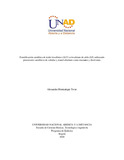Mostrar el registro sencillo del ítem
Esterificación catalítica de ácido levulínico (ALV) a levulinato de etilo (LE) utilizando precursores catalíticos de cobalto y etanol absoluto como reactante y disolvente.
| dc.contributor.advisor | Castellanos Blanco, Nahury Yamile | |
| dc.coverage.spatial | cead_-_josé_acevedo_y_gómez | spa |
| dc.creator | Montealegre Tovar, Alexandra | |
| dc.date.accessioned | 2020-03-05T17:18:34Z | |
| dc.date.available | 2020-03-05T17:18:34Z | |
| dc.date.created | 2020-03-05 | |
| dc.identifier.uri | https://repository.unad.edu.co/handle/10596/31631 | |
| dc.description.abstract | En el presente trabajo de grado se presenta la síntesis del levulinato de etilo (LE) mediante la esterificación catalítica del ácido levulínico (ALV) en presencia de etanol (EtOH), proceso mediado por un catalizador de cobalto (Co+2); cloruro de cobalto hexahidratado (CoCl2*6H2O) y se comparó la eficiencia del mismo respecto a la sal de acetato de cobalto (Co+2) (Co(CH3COO)2). Se realizaron varias reacciones modificando la temperatura, cantidad de catalizador, proporción molar de ALV: EtOH y duración del proceso con el fin de establecer las condiciones ideales en las cuales se obtiene un mayor rendimiento de LE y conversión de ALV, el rendimiento de LE y la conversión del ALV fueron evaluados mediante CG-EM. Derivado de esta reactividad se encontró que las mejores condiciones para obtener el mayor rendimiento de LE correspondiente a 48,5% se dan empleando 100°C durante 3 h de reacción y agitación constante (400 rpm) con una proporción molar de catalizador de 4 % mol (57.4 mg, 0.24 mmol) y una proporción molar de sustratos ALV:EtOH de 1:25; se halló también un subproducto de reacción tipo γ-acetoxi-γ-butirolactona, correspondiente al acetato de 2-metil-5-oxotetrahidro2-furanilo (lactona), derivado del proceso en un rendimiento del 6% mol. Finalmente, se propuso un mecanismo de reacción para explicar la ruta y formación del producto principal y el subproducto obtenido; el levulinato de etilo se obtuvo mediante la reacción de esterificación de ALV y el acetato de 2-metil-5-oxotetrahidro-2-furanilo se obtuvo mediante hidrogenación catalítica por trasferencia ya que se comprobó que el etanol actúa como fuente de hidrógeno en el proceso. La ruta de reacción empleada resulta ser prometedora para la síntesis del LE y permite reemplazar el uso tradicional de catalizadores ácidos solubles disminuyendo así la generación de residuos peligrosos, esta última característica y el uso de materias primas renovables contribuyeron al cumplimiento de los principios de la química verde, dentro de los cuales se encuentra el uso de métodos que generen sustancias con toxicidad baja o nula para la salud y el ambiente, por otro lado, los sustratos y productos obtenidos son biodegradables y se realizó el proceso bajo condiciones de reacción moderadas, empleando temperaturas entre 60 y 100 ºC, tiempos de reacción menores a 5h y a presión atmosférica. | spa |
| dc.format | ||
| dc.title | Esterificación catalítica de ácido levulínico (ALV) a levulinato de etilo (LE) utilizando precursores catalíticos de cobalto y etanol absoluto como reactante y disolvente. | |
| dc.type | Proyecto de investigación | |
| dc.subject.keywords | Esterificación | spa |
| dc.subject.keywords | Ácido levulínico | spa |
| dc.subject.keywords | Levulinato de etilo | spa |
| dc.subject.keywords | Catálisis ácida | spa |
| dc.description.abstractenglish | This degree work shows the synthesis of ethyl levulinate (LE) by catalytic esterification of levulinic acid (ALV) in the presence of ethanol (EtOH), a process mediated by a cobalt (Co+2) catalyst; cobalt chloride hexahydrate (CoCl2 * 6H2O) and it was compared its efficiency with the cobalt acetate salt (Co (CH3COO)2). Several conditions reaction were tested by modifying temperature, amount of catalyst, molar ratio of ALV: EtOH and time reaction in order to establish the ideal conditions under which a higher LE yield and ALV conversion are obtained. Both, LE yield and conversion of ALV were evaluated by gas chromatography coupled to mass spectrometry, this determination was useful to find the best conditions for obtaining the highest LE yield corresponding to 48.5%, these conditions are given at 100 °C in 3h applying constant agitation (400rpm) using 4% (57.4 mg, 0.24 mmol) amount of catalyst and a molar proportion of substrates between ALV: EtOH of 1:25. A reaction by-product type γ-acetoxy-γ-butyrolactone corresponding to 2- methyl-5-oxotetrahydro-2-furanyl acetate, was also found (lactone) with a yield of 6% mol. Finally, a reaction mechanism was proposed in order to explain the route and formation of the main product and the by-product obtained from the evaluated process; ethyl levulinate was obtained by the ALV esterification reaction and 2-methyl-5-oxotetrahydro2-furanyl acetate was obtained by catalytic transfer hydrogenation since it is proven that ethanol acts as a source of hydrogen in the process. The reaction route used turns out to be promising for the LE synthesis and it allows replacing the traditional use of soluble acid catalyst, thus reducing the generation of hazardous waste, this last characteristic and the use of raw materials derived from renewable sources of energy contributed to compliance with the green chemistry principles, these principles include the use of methods that generate substances with low or no toxicity for health and the environment, on the other hand, the substrates and products obtained are biodegradable and the process was carried out under mild conditions of temperature (100 ° C) and atmospheric pressure. | spa |
| dc.subject.category | Química | spa |
| dc.subject.category | Materiales | spa |















